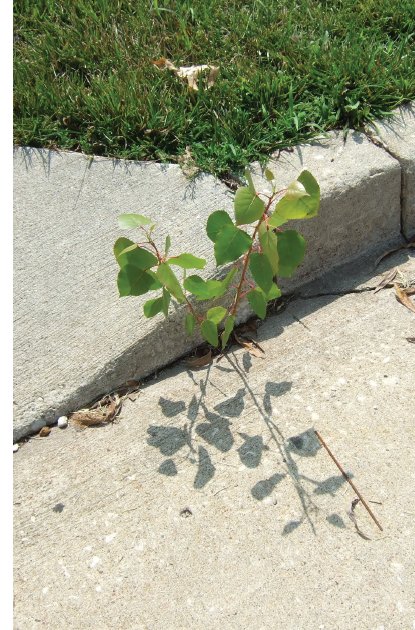AgEBB-MU CAFNR Extension
Green Horizons
Volume 20, Number 3
September 2016
Urban Forestry
Role for Natural Reproduction in Landscaping
By Eugene L. Brunk
Every now and then, a homeowner may see some sort of woody "sprout" growing in their yard, flower bed, or some other out of the way place that doesn't get mowed regularly. Many wonder what that plant is, and then assume it's a weed, so they pull it or grub it out of the way. Unfortunately, we may be missing an opportunity to let the "sprout" grow into a valuable asset for our landscape -- particularly if it's growing in a spot that could use a tree. Foresters call these plants natural regeneration (or more correctly, natural reproduction), and they may have come from a very desirable species, such as an oak or redbud. Of course, "the wild thing in the yard" more often comes from a more prolific, undesirable species such as silver maple or Siberian elm. Then it is truly a "weed," and needs to be removed.
 |
A cottonwood seedling that is definitely a "weed." |
For those of you who don't know the difference, here is some help, a weed is simply a plant that is out of place. It's much the same as the difference between soil and dirt, i.e., dirt is soil that's out of place. We all should know by now that all plants, regardless of species, are valuable within their natural setting. Thus, a silver maple or cottonwood growing in the woods down by the creek serves a very useful purpose in protecting the stream corridor, providing wildlife habitat, etc. However, if either of these species is growing in your front yard, or, worse yet, in your spouse's prize flower bed, the silver maple or cottonwood can cause a great deal of consternation and expense. Something better should be in your yard.
Anyway, I digress.
If you find a woody sprout in a desirable spot for a tree, I encourage you to find out if it is a desirable species for that spot. This may take some technical assistance if you are not familiar with identifying trees that are only a few inches tall, and have only 2 or 3 leaves. Try to get it identified without removing any of the leaves. I'd recommend leaving it for a year or so, until it is a little larger, in order to determine what it is. You can always remove it later, with little hassle, if it turns out to be a "weed."
Taking advantage of naturally-occurring seedlings can be a good strategy for managing your landscape, if they meet the criteria of the "right tree, right place" approach. Of course, I do not recommend keeping even a good species (such as an oak) in your favorite day-lily bed. But, then again, you might be able to transplant that good old white oak, or red oak seedling to that spot along the back fence where you've been contemplating filling in with "something." If the local squirrels buried the acorn, then forgot about it, the resulting little oak tree may be just the thing for your landscape, since it's one of the locals too. Best of all, it's also free!
Give natural regeneration a try, when you get the opportunity!
